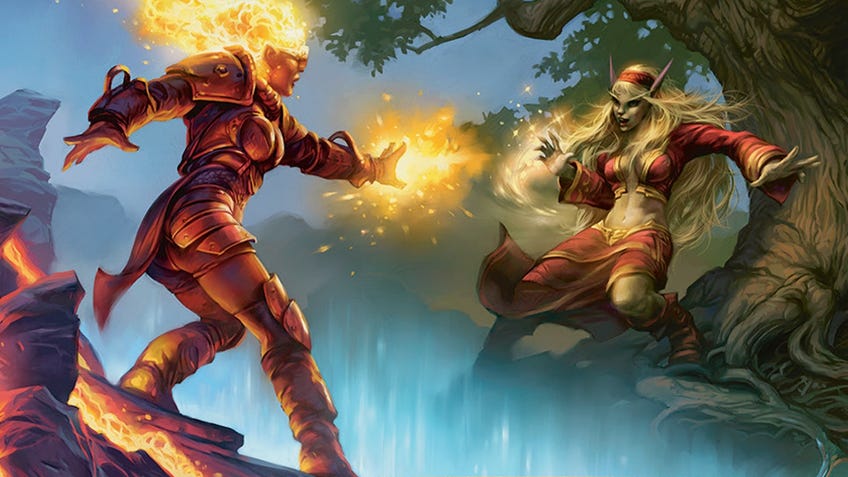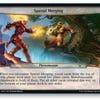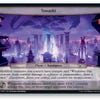Magic: The Gathering revives 14-year-old multiplayer format Planechase as a Commander offshoot
The first new Planechase cards since 2012 will come bundled with March of the Machines’ Commander precons.
Tucked away as it was amid last weekend’s March of the Machines’ news flurry, Magic: The Gathering’s plans to revive the Planechase format might have skated by most fans unnoticed. This oddity of a multiplayer mode for the popular trading card game will receive its first new cards in a decade, but any future beyond that point remains uncertain.
Planechase’s return was tucked amidst a long blog post by publisher Wizards of the Coast that detailed the apparent glut of plans for upcoming set March of the Machines. As with 2022’s mid-year set, Streets of new Capenna, this culminatory expansion will be accompanied by five preconstructed Commander decks. Unlike those past releases, each deck will also contain 10 oversized Planechase cards - five new and five reprints - that will allow players to experience Planechase right out of the box.
The blog post was fairly slim on details surrounding Planechase’s fate after March of the Machine ends, but that’s apparently true for much of Magic: The Gathering. Notable designers such as Mark Rosewater have publicly stated multiple times that May’s event set will mark several big changes in the TCG’s narrative and mechanical structure. Dual-faced, transforming Battle cards - a wholly new type - are one indicator of that direction. Could Planechase’s return be another, or will it sink back into novelty status once the fanfare fades away?
What is Planechase, anyway?
Planechase first hit kitchen tables all the way back in 2009 as four themed boxes, each containing a 60-card deck and 10 oversized cards that depicted one of a couple dozen planes from within MTG’s multiverse. Groups would shuffle up their standard decks and add ten Plane cards per combatant to the match’s Plane deck, which is either shared amongst all opponents or kept separate like an in-game sideboard. At the start of the game, the first player would flip over a Plane card, and its effect would take hold.
All Plane cards carried at least one ongoing effect, adding an extra rule or stipulation to matches as long as it remained face-up on the field. These effects ranged from increasing hands sizes to keeping creatures from untapping to increasing the amount of Mana gained when tapping lands. Some cards also bore Chaos effects that would only activate when a player rolled a certain face on the planar die.
That’s right - Planechase introduced dice to MTG long before the Dungeons & Dragons crossover set Adventures in the Forgotten Realms did. A single six-sided die was rolled any time a player wanted to Planeswalk from the current plane to locations unknown. During either of the two main phases on their turn, a player could roll a die that featured nothing on four of its faces, and two special symbols. A blank face resulted in a dud, while the Planar symbol meant flipping over the next card on the stack. The Chaos face did exactly what it advertised, often to that player’s detriment.
Players could continue rolling and flipping as long as they had Mana to burn - each successive Planeswalk cost one more cumulative mana per turn. Planechase 2012, the first and only real expansion to the format, added “phenomenon cards” that issued a table-wide effect when drawn. This might wipe out every creature currently in play, let everyone draw four cards, or even reverse the turn order. The random, chaotic element wasn’t everyone’s cup of tea but spiced up matches and kept the usual meta-chasing deck builders from brute forcing wins in what was ultimately a casual format.
How is Planechase changing?
It isn’t, really. March of the Machine’s preconstructed commander decks will contain newly designed planes alongside reprints of the older ones - a grand total of 50 amongst the quartet - but Wizards of the Coast hasn’t yet announced any new rules changes or overhauls. Old fans and curious newcomers can expect it to play out exactly as before, except for the inherent suggestion of using the convenient 100-card singleton deck, instead. Which is fine - Planechase never cared much about the size and composition of a player’s deck, as its rule-bending effects were more sweeping and broad.
It also remains to be seen if MTG will support Planechase beyond March of the Machines. Wizards’ announcement called this set “the perfect time for Planechase” since it serves as a whirlwind tour of the worlds being invaded by Elesh Norn and her modern incarnation of Phyrexia. The addition of new cards lends some hope to those optimistic for a third Planechase product sometime in the future, but this wouldn’t be the first time Wizards has trotted out a neglected format for promotional reasons (I’m looking at you, Two-headed Giant).
Planechase doesn’t get the respect it deserves because it throws wrenches into a TCG often conducted like a well-oiled machine. It’s like playing Super Smash Bros. with items on after years of only experiencing Final Destination with anime sword losers (please ignore my obvious bias). Attaching it to Commander could reintroduce the random, kitchen table chaos back into a format that has arguably begun to calcify under the weight of so much official attention and continuous product releases.












